The long history of Madrid told briefly
Do you have 3 minutes? Read the long history of Madrid told as a brief tale.
THE (ALMOST) LEGENDARY ROMAN PAST (218 BC – 409 AD)
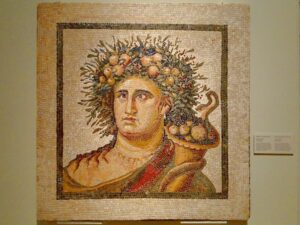 For a long time, Madrid pretended to have had a mythical prestigious Roman origin. BuT the truth is that the Romans only established some farms, a few country-houses and an inn in today’s Madrid town soil.
For a long time, Madrid pretended to have had a mythical prestigious Roman origin. BuT the truth is that the Romans only established some farms, a few country-houses and an inn in today’s Madrid town soil.
A SMALL MUSLIM (THEN CHRISTIAN) MEDIEVAL TOWN (850 – 1516)
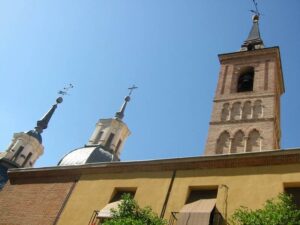 The Emir (prince) of Córdoba, Mohammed I (850-866 AD), chose Madrid to build a fortress defending Toledo from the Northern Christian kings. Two centuries later, the small Muslim fortress (Mayrit) was conquered by Christian King Alfonso VI of Castille in 1085 AD.
The Emir (prince) of Córdoba, Mohammed I (850-866 AD), chose Madrid to build a fortress defending Toledo from the Northern Christian kings. Two centuries later, the small Muslim fortress (Mayrit) was conquered by Christian King Alfonso VI of Castille in 1085 AD.
THE EMPEROR’S FAVORITE HUNTING PLACE (1516 – 1556)
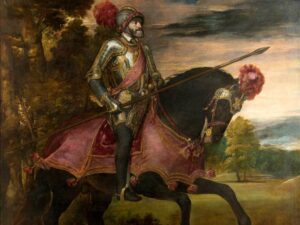 Charles V, Emperor of Germany and King of Spain had a secret preference for the tiny town of Madrid, because of the richness of its hunting grounds. He reformed the old Arab fortress and the Palace of El Pardo to spend as much time as possible in Madrid, while important civil servants bought or built houses in town.
Charles V, Emperor of Germany and King of Spain had a secret preference for the tiny town of Madrid, because of the richness of its hunting grounds. He reformed the old Arab fortress and the Palace of El Pardo to spend as much time as possible in Madrid, while important civil servants bought or built houses in town.
MADRID, HABSBURG’S WORLD CAPITAL (1556– 1700)
 Philip II looked for a permanent capital in the center of Spain, far from Spanish many enemies. He finally chose Madrid against Toledo, Segovia or Avila probably because the city didn’t have any Archbishop and because the city was loyal to the Emperor during the Communal War. The fact is that the small town grew into a big capital where political leaders, civil servants and diplomats made their best for Spain to remain the World hegemonic power, while writers such as Cervantes and artists such as Velázquez came to Madrid to earn their life and gain recognition from their contemporaries.
Philip II looked for a permanent capital in the center of Spain, far from Spanish many enemies. He finally chose Madrid against Toledo, Segovia or Avila probably because the city didn’t have any Archbishop and because the city was loyal to the Emperor during the Communal War. The fact is that the small town grew into a big capital where political leaders, civil servants and diplomats made their best for Spain to remain the World hegemonic power, while writers such as Cervantes and artists such as Velázquez came to Madrid to earn their life and gain recognition from their contemporaries.
PLATFORM FOR THE BOURBON’S REFORM (1700– 1808)
 When the new dynasty, the Bourbons, was raised to the throne, Spain was no longer the hegemonic power in Europe. Nevertheless, they desperately tried to recover their former position through ambitious economic and administrative reforms. Accordingly, Madrid was transformed into a more efficient capital and embellished as instrument of Spain’s “new image”.
When the new dynasty, the Bourbons, was raised to the throne, Spain was no longer the hegemonic power in Europe. Nevertheless, they desperately tried to recover their former position through ambitious economic and administrative reforms. Accordingly, Madrid was transformed into a more efficient capital and embellished as instrument of Spain’s “new image”.
MADRID LOSING ITS EMPIRE (1808– 1833)
 In 1808, Madrid was occupied by Napoleon’s troops. That was the cruelest evidence of Spain’s extreme decadence: the city had never been invaded by a foreign Army before. Popular revolt started in Madrid. It was soon crashed, but it stimulated uprisings everywhere, ultimately regaining independence with the help of Wellington after a five years War against the French. One of the consequences of this long War was exhausted Spain being unable to prevent the Independence of Hispanic America.
In 1808, Madrid was occupied by Napoleon’s troops. That was the cruelest evidence of Spain’s extreme decadence: the city had never been invaded by a foreign Army before. Popular revolt started in Madrid. It was soon crashed, but it stimulated uprisings everywhere, ultimately regaining independence with the help of Wellington after a five years War against the French. One of the consequences of this long War was exhausted Spain being unable to prevent the Independence of Hispanic America.
A “WALTZ AND PLOTS” DECADENT COURT (1833– 1931)
 Ruined by the Napoleonic and American Wars, Spain was suddenly a poor country, economically backwards, without prestige or influence abroad. Madrid’s Royal Palace and Royal Theatre were the playground of the decadent court of Monarchs who had even lost grip of domestic policy. Meanwhile, the Senate, the Congress, the military barracks and the cafés in Madrid were the scenario of political life during Spanish long march to democracy.
Ruined by the Napoleonic and American Wars, Spain was suddenly a poor country, economically backwards, without prestige or influence abroad. Madrid’s Royal Palace and Royal Theatre were the playground of the decadent court of Monarchs who had even lost grip of domestic policy. Meanwhile, the Senate, the Congress, the military barracks and the cafés in Madrid were the scenario of political life during Spanish long march to democracy.
THE REPUBLIC AND THE SPANISH CIVIL WAR IN MADRID (1931-39)
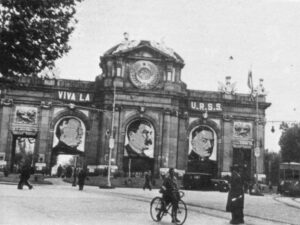 In 1931, The Republic was proclaimed in Madrid, among massive demostrations of joy. Five years later, the hope of general welfare turned sour, the government was unable to control right-wing and left-wing extremists and violence took the front-page of all newspapers. A military coup backed by monarchists and fascists failed to bring down the Republic government in a few days: a 3-years-long Civil War started. Madrid will be in the hands of the Republic to the very end of the War. Being just a few miles away from the front, it would suffer heavy bombing and extreme shortage, while fierce repression by leftists against their right-wing neighbours reproduced right-wing terror against left-wing supporters on the other side of the line.
In 1931, The Republic was proclaimed in Madrid, among massive demostrations of joy. Five years later, the hope of general welfare turned sour, the government was unable to control right-wing and left-wing extremists and violence took the front-page of all newspapers. A military coup backed by monarchists and fascists failed to bring down the Republic government in a few days: a 3-years-long Civil War started. Madrid will be in the hands of the Republic to the very end of the War. Being just a few miles away from the front, it would suffer heavy bombing and extreme shortage, while fierce repression by leftists against their right-wing neighbours reproduced right-wing terror against left-wing supporters on the other side of the line.
Madrid under Franco (1939-1975)
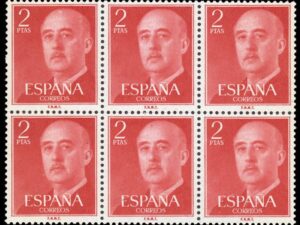 Repression (in the opposite direction) and shortage (because of international isolation) went on when Franco’s nationalist forces entered the capital. Since the mid ’50s, a certain political softening allowed foreign aid to come and a progressive economical development was soon translated in fast urban expansion of the capital. Social transformation took place inevitably in the streets with avid emulation of lifestyles seen abroad or brought home by a growing number of foreign tourists.
Repression (in the opposite direction) and shortage (because of international isolation) went on when Franco’s nationalist forces entered the capital. Since the mid ’50s, a certain political softening allowed foreign aid to come and a progressive economical development was soon translated in fast urban expansion of the capital. Social transformation took place inevitably in the streets with avid emulation of lifestyles seen abroad or brought home by a growing number of foreign tourists.
Madrid free (Since 1975)
 The end of Franco’s regime allowed democracy to spring in Spain, while Madrid burst in frenetic political, social and cultural activity. Madrid’s day-and-night vitality and hedonism astonishes visitors. Artistic creativity animated specially the channels of massive popular culture: photography, cinema and music, out of which new names, such as Pedro Almodóvar, won international recognition. Nowadays, Madrilenian creativity continues to cross borders, and travelers who visit us are pleased to discover Madrid’s vitality at any hour of the day or night, the tolerant character of the city, and the commitment to become a modern capital, with Madrid Río and Madrid Central as the most ambitious and emblematic projects
The end of Franco’s regime allowed democracy to spring in Spain, while Madrid burst in frenetic political, social and cultural activity. Madrid’s day-and-night vitality and hedonism astonishes visitors. Artistic creativity animated specially the channels of massive popular culture: photography, cinema and music, out of which new names, such as Pedro Almodóvar, won international recognition. Nowadays, Madrilenian creativity continues to cross borders, and travelers who visit us are pleased to discover Madrid’s vitality at any hour of the day or night, the tolerant character of the city, and the commitment to become a modern capital, with Madrid Río and Madrid Central as the most ambitious and emblematic projects






